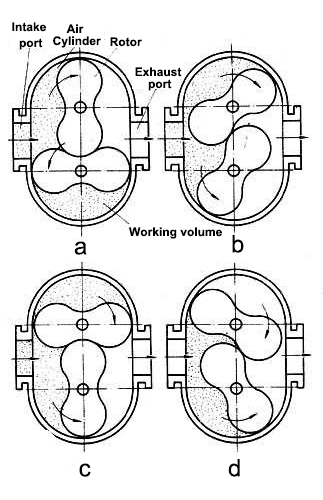What is a Roots Blower?
The Roots blower is a type of twin-rotor compressor, where the axes of the two rotors are parallel to each other. They are driven by the prime mover through a pair of synchronized gears, rotating in opposite directions at a constant speed. The Roots blower is a positive displacement blower, and the volume of air conveyed is directly proportional to the rotational speed. With each revolution of the three-lobe impeller, the two lobes intake and exhaust air three times.
What are the components of a Roots blower?
Casing: Mainly used to support the wall panels, impeller, silencer, and for fixation purposes. Wall panels: Primarily used to connect the casing and impeller, providing support for the impeller's rotation and contributing to endface sealing.
Impeller: The rotating part of the Roots blower, available in two-lobe and three-lobe configurations. Due to the advantages of lower air pulsation and noise, smooth operation, etc., three-lobe impellers have gradually replaced two-lobe Roots blowers.
Oil tank: The internal components include wrapped bearings, gears, lubricating oil, etc.
Silencer: Used to reduce the noise generated by the air pulsation during the intake and exhaust of the Roots blower.
The working principle of Roots blower
The working principle of a Roots blower is based on the rotation of the Roots rotors and the variation in the internal chambers. As the rotors rotate, the small gap between them allows gas to be drawn in and compressed. As the rotors continue to rotate, the compressed gas is pushed to the outlet of the casing, further compressed, and discharged. In this process, intake and exhaust valves control the flow of gas, ensuring that the gas can only move in one direction.

The Roots blower belongs to the positive displacement rotary blower category. This type of compressor relies on synchronous gears at the rotor shaft ends to maintain the engagement of the two rotors. The concave surface of each recess on the rotor, in conjunction with the cylinder's inner wall, forms the working volume. During the rotation of the rotor, gas is drawn in from the intake port and, as it moves towards the exhaust port, momentarily connects with it. Due to the backflow of gas with higher pressure near the exhaust port, the pressure in the working volume suddenly increases, and then the gas is delivered to the exhaust passage. The two rotors do not contact each other; their sealing is achieved by a tightly controlled gap, preventing the discharged gas from being contaminated by lubricating oil.
Roots Blower vs. Centrifugal Fan
Roots blowers and centrifugal fans are both types of air handling equipment used in various industrial and HVAC (heating, ventilation, and air conditioning) applications. While they share the common purpose of moving air, their operating principles and manufacturing precision differ significantly. Here are the main distinctions between Roots blowers and centrifugal fans:
Different Working Principles
The centrifugal fan utilizes curved blades, relying on centrifugal force to propel the gas towards the casing, whereas the Roots blower employs two 8-shaped impellers with a very small gap between them. The gas is squeezed through the outlet by the compression of these two blades. Due to the distinct operating principles, they generally have different working pressures, with the Roots blower producing higher outlet pressures compared to the centrifugal fan.
There is a Variance in Airflow
Typically, Roots blowers are used in applications where the airflow requirement is not significant, but there is a need for high pressure. On the other hand, centrifugal fans are employed in situations where low pressure and high airflow are required.
Different Manufacturing Precision
Roots blowers demand high precision and strict assembly requirements, while centrifugal fans are relatively less stringent in these aspects.
Applications
The Roots blower is characterized by its well-sealed construction, smooth operation, low noise, high airflow, and energy efficiency. Roots blowers are extensively utilized in industries such as chemical, water treatment, printing, textile, and construction for pneumatic conveying, pneumatic power transmission, ventilation, and air exchange applications.
Chemical Industry
In chemical processes, Roots blowers are used for various tasks such as conveying chemical raw materials, transporting reaction gases, aerating mixing, sewage treatment, ventilation and exhaust, gas boosting, and pulse dust removal. These applications involve Roots blowers providing pneumatic conveying performance.
Wastewater Treatment Industry
The wastewater treatment industry requires injecting oxygen into sewage tanks to facilitate the oxidative synthesis process of microorganisms. Roots blowers, based on different water depths, provide a quantitative supply of oxygen, promoting the growth of microorganisms and aiding in the decomposition of suspended solids and organic compounds in sewage. It is a crucial equipment in wastewater treatment.
Aquaculture Industry
Industrial-scale aquaculture often requires large-scale oxygen supply. By installing aeration discs at the bottom of ponds and connecting them to Roots blowers, oxygen can be periodically supplied to the water, increasing the oxygen content and helping aquaculture enterprises enhance production.
Desulfurization and Oxidation Industry
Power plants, during the desulfurization and oxidation process, need to treat flue gas, which is achieved through chemical reactions. In this process, the sulfur dioxide content significantly decreases, but sufficient oxygen is required for oxidation. Roots blowers are used to provide the required oxygen, ensuring efficient operation of chemical reactions to meet emission standards.
Powder Conveying Industry
Roots blowers themselves cannot convey gases containing a large amount of solid media; they are primarily used for conveying clean air. In powder conveying, Roots blowers provide pneumatic kinetic energy, assisting in the conveyance of the required powder.
In summary, Roots blowers play a crucial role in gas conveying and oxygen supply in multiple industries, facilitating the smooth operation of various industrial processes.
ATO offers a variety of styles of blowers, air blowers, axial fans, and regenerative blowers to meet the requirements of different applications. Whether you need a low-pressure or high-pressure system, we provide a range of models with different flow rates and pressure differentials, allowing you to choose the product that best suits your specific needs.

